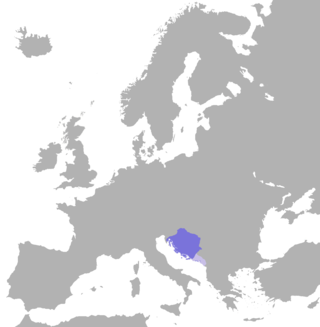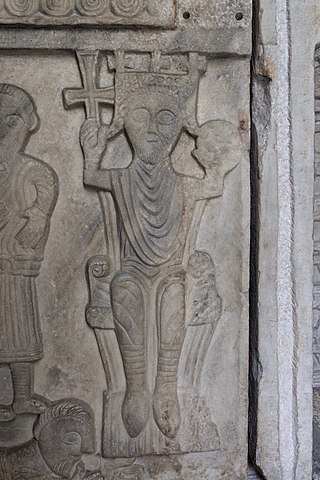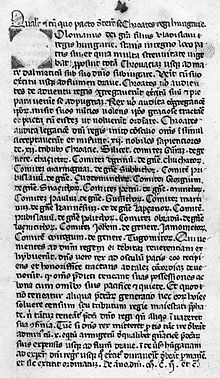
The Kingdom of Croatia entered a personal union with the Kingdom of Hungary in 1102, after a period of rule of kings from the Trpimirović and Svetoslavić dynasties and a succession crisis following the death of king Demetrius Zvonimir. With the coronation of King Coloman of Hungary as "King of Croatia and Dalmatia" in 1102 in Biograd, the realm passed to the Árpád dynasty until 1301, when the (male) line of the dynasty died out. Then, kings from the Capetian House of Anjou, who were also cognatic descendants of the Árpád kings, ruled the kingdoms. Later centuries were characterized by conflicts with the Mongols, who sacked Zagreb in 1242, competition with Venice for control over Dalmatian coastal cities, and internal warfare among Croatian nobility. Various individuals emerged during the period, such as Paul I Šubić of Bribir, who was representing the most powerful Croatian dynasty at the time, the Šubić noble family. These powerful individuals were on occasion able to de facto secure great deal of independence for their fiefdoms. The Ottoman incursion into Europe in the 16th century significantly reduced Croatian territories and left the country weak and divided. After the death of Louis II in 1526 during the Battle of Mohács and a brief period of dynastic dispute, both crowns passed to the Austrian House of Habsburg, and the realms became part of the Habsburg monarchy.

The Kingdom of Croatia, or Croatian Kingdom, was a medieval kingdom in Southern Europe comprising most of what is today Croatia, as well as most of the modern-day Bosnia and Herzegovina. The Croatian Kingdom was ruled for part of its existence by ethnic dynasties, and the Kingdom existed as a sovereign state for nearly two centuries. Its existence was characterized by various conflicts and periods of peace or alliance with the Bulgarians, Byzantines, Hungarians, and competition with Venice for control over the eastern Adriatic coast. The goal of promoting the Croatian language in the religious service was initially introduced by the 10th century bishop Gregory of Nin, which resulted in a conflict with the Pope, later to be put down by him. In the second half of the 11th century Croatia managed to secure most coastal cities of Dalmatia with the collapse of Byzantine control over them. During this time the kingdom reached its peak under the rule of kings Peter Krešimir IV (1058–1074) and Demetrius Zvonimir (1075–1089).

Croatian nobility was a privileged social class in Croatia during the Antiquity and Medieval periods of the country's history. Noble families in the Kingdom of Croatia included high ranking populates from Slavonia, Dalmatia, Istria, and Republic of Ragusa. Members belonged to an elite social hierarchy, normally placed immediately behind blood royalty, that possessed considerably more privileges or eminence than most other classes in a society. Membership thereof typically was often hereditary. Historically, membership in the nobility and the prerogatives thereof have been regulated or acknowledged by the monarch. Acquisition of sufficient power, wealth, military prowess or royal favour enabled commoners to ascend into the nobility. The country's royalty was heavily influenced by France's nobility resulting members of the Royal Courts to assume French titles and practices during French occupation. The controversial assumption of French practices contributed to wide spread political and social elitism among the nobles and monarch. The nobility regarded the peasant class as an unseen and irrelevant substrata of people which lead to high causality revolts and beheadings as well as sporadic periods of intense domestic violence.

Demetrius Zvonimir was a King of Croatia and Dalmatia from 1075 or 1076 until his death in 1089. Zvonimir also served as Ban of Croatia (1064–1074), and was named Duke of Croatia in around 1075. His native name was Zvonimir, but adopted the forename Demetrius at his coronation.

Nada Klaić was a Croatian historian. She was a Croatian medievalist of the 20th century. A substantial part of the work was devoted to criticism of medieval sources.
Stephen II was the last member of the Trpimirović dynasty and last native king of Croatia to rule the entire medieval Croatian Kingdom. Stephen's father was Gojslav II, the younger brother of Peter Krešimir IV of Croatia. Stephen was duke of Croatia under Krešimir around 1066.

Ban of Croatia was the title of local rulers or office holders and after 1102, viceroys of Croatia. From the earliest periods of the Croatian state, some provinces were ruled by bans as a ruler's representative (viceroy) and supreme military commander. In the 18th century, Croatian bans eventually became the chief government officials in Croatia.
The "Lands of the Hungarian Crown" was the titular expression of Hungarian pretensions to the various territories that the King of Hungary ruled nominally or absolutely.
This is the family tree of the House of Šubić, a Croatian noble family, from 1066 to 1456.
The Duke of Slavonia, also Duke of Dalmatia and Croatia and sometimes Duke of "Whole Slavonia", Dalmatia and Croatia was a title of nobility granted several times in the 13th and 14th centuries, mainly to relatives of Hungarian monarchs or other noblemen. The title of duke signified a more extensive power than that of the Ban of Slavonia or Ban of Croatia.

The Kačić family was one of the most influential Croatian noble families, and was one of the Croatian "twelve noble tribes" described in the Pacta conventa and Supetar Cartulary. Historical sources refer to members of this family as nobles in the area of the Luka županija in the Zadar-Biograd hinterland, as the lords (knezes) of Omiš, and as the lords of the Makarska Riviera. Another prominent branch of the family, Kacsics, was part of the Hungarian nobility and from it branched many families including Szécsényi.

The Gusić family, also known as Gušić, was one of the twelve noble tribes of the Kingdom of Croatia, mentioned in the Pacta conventa. They originated from the hinterland of Biograd in the medieval Luka and Sidraga županijas, where they are recorded at least since the 11th century. Their main regions of influence were Krbava and Gacka, where they often served as župans and knezes at least since the early 13th century. In the 14th century branched Posedarski who seated in Posedarje, and Kurjakovići who as magnates managed to gather much wealth and have high official positions at the Hungarian royal court as well two of their members became Ban of Croatia. As experienced warriors, they actively participated in the Croatian–Ottoman and late Ottoman–Venetian Wars. Direct descendants of the tribe with the surname Gusić, and possibly Gušić, live even today in Croatia and Slovenia.
The twelve noble tribes of Croatia, also known as twelve noble families of Croatia, was a medieval institution of nobility, alliance, or narrow noble community in the Kingdom of Croatia, which can be traced back at least to the 14th century, while the first mention of the institution was in the Pacta conventa document, which is supposedly a later copy of the original from 1102. Regardless of possible earlier references, the first verifiable mention dates from 1350, while the last from 1459. It is considered that by socio-economic power it was composed of lower and middle nobility, which had a privilege of retain and use of heirdom, tax exemption, and limited military obligations to the king. The twelve tribes are Čudomirić, Gusić, Kačić, Kukar, Jamomet, Lasničić, Lapčan and Karinjan, Mogorović, Poletčić, Snačić, Šubić, and Tugomirić.
The Čudomirić family was one of the twelve noble tribes of the Kingdom of Croatia, mentioned in the Pacta conventa and Supetar Cartulary.
The Kukar family was one of the twelve noble tribes of the Kingdom of Croatia, mentioned in the Pacta conventa and Supetar Cartulary.

The Lapčan family was one of the twelve noble tribes of the Kingdom of Croatia, mentioned in the Pacta conventa. Their seat was in the town of Lapac in the former Luka županija, Dalmatia. Their noble rights were confirmed in the second half of the 13th century until when were jobbágy. In the 14th century branched Karinjani, with seat in Karin, whose name would eventually become more dominant than of Lapčan. The family's coat of arms is described in the 15th century and united with the one by Kurjaković family in the mid-17th century, it became used by the Austrian-Bavarian Sinzendorf noble family.
The Snačić family, sometimes called Svačić and Svadčić, was one of the twelve noble tribes of Croatia, mentioned in the Pacta conventa and Supetar Cartulary. Among the oldest known members of the family is Petar Snačić, who is very likely to have been the last Croatian king of Croatian descent.

The Jamomet family, also known as Jamometi, Jamometić or Jamometović, was one of the twelve noble tribes of the Kingdom of Croatia, mentioned in the Pacta conventa (1102). Originally from Dalmatia, in the 14th century the surname is also mentioned in Zachlumia, possibly being a branch of the Croatian tribe, but the relationship remains uncertain.
The Tugomirić family, sometimes called Tugomerić or Tugomorić, was one of the twelve noble tribes of the Kingdom of Croatia. It was mentioned in the Pacta conventa (1102).

Stephen II was a Croatian–Hungarian prelate of the Catholic Church who served as Bishop of Zagreb from 1225 until his death in 1247.










